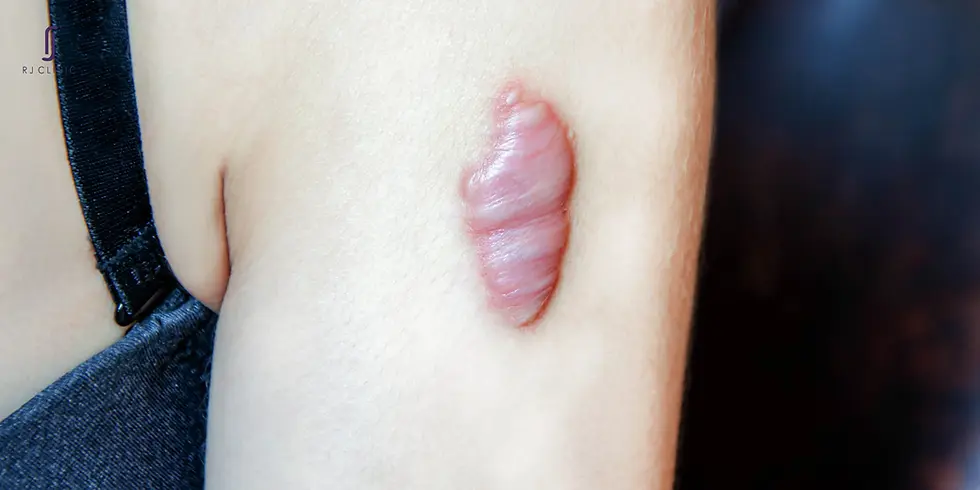Understanding Keloid Scars and Treatment Options
- RJ CLINIC
- 5 days ago
- 4 min read
Scars tell stories. Sometimes, they remind us of healing and strength. Other times, they can be a source of discomfort or self-consciousness. If you’ve noticed a raised, thickened scar that seems to grow beyond the original wound, you might be dealing with a keloid. These scars can be tricky, but understanding them is the first step toward effective treatment. Let’s dive into what keloid scars are, why they happen, and what treatment options are available to help you feel confident in your skin again.
What Is Keloid Scar Treatment?
When it comes to managing keloid scars, treatment is all about reducing their size, appearance, and discomfort. Unlike regular scars, keloids grow beyond the boundaries of the original injury. This makes them more challenging to treat, but not impossible.
Keloid scar treatment focuses on:
Flattening the raised scar tissue
Soothing any itching or pain
Preventing the scar from growing further
Improving the overall look of the skin
There are several approaches to treatment, and often, a combination works best. From non-invasive methods like silicone sheets and steroid injections to more advanced options like laser therapy and surgery, each has its place depending on the scar’s size, location, and your skin type.
If you’re considering treatment, it’s important to consult with a specialist who understands the nuances of keloid scars. Personalized care ensures the best results and minimizes the risk of the scar returning or worsening.

What Causes Keloids?
Understanding why keloids form can help you take steps to prevent them or manage them better. Keloids develop when the skin produces too much collagen during the healing process. Collagen is the protein that helps repair wounds, but in keloids, this process goes into overdrive.
Several factors can increase the likelihood of keloid formation:
Genetics: Some people are more prone to keloids, especially those with darker skin tones.
Skin injuries: Cuts, burns, acne, piercings, or surgical wounds can trigger keloid growth.
Location: Keloids often appear on the chest, shoulders, earlobes, and upper back.
Age: Younger individuals tend to develop keloids more frequently.
Knowing these factors can help you be cautious with skin injuries and seek early treatment if you notice abnormal scar growth.

Common Keloid Scar Treatment Options
Let’s explore some of the most effective treatments available today. Each option has its benefits and considerations, so it’s good to know what might work best for your situation.
1. Silicone Gel Sheets and Dressings
Silicone sheets are a simple, non-invasive way to soften and flatten keloid scars. They work by hydrating the scar tissue and protecting it from irritation.
How to use: Apply the sheet over the scar for several hours daily.
Benefits: Easy to use, painless, and suitable for all skin types.
Limitations: Works best on newer scars and requires consistent use over weeks or months.
2. Steroid Injections
Corticosteroid injections help reduce inflammation and slow down collagen production.
How it works: Injected directly into the scar, steroids can shrink the keloid and relieve itching.
Frequency: Usually given every 4 to 6 weeks.
Considerations: May cause skin thinning or discoloration if overused.
3. Laser Therapy
Laser treatments target the blood vessels in the scar, reducing redness and flattening the tissue.
Advantages: Improves scar texture and color.
Sessions: Multiple treatments are often needed.
Side effects: Temporary redness or swelling.
4. Surgical Removal
Surgery can remove large or stubborn keloids, but it carries a risk of the scar returning, sometimes larger than before.
Best practice: Often combined with steroid injections or radiation therapy post-surgery to prevent recurrence.
Who should consider: Those with significant discomfort or functional issues caused by the keloid.
5. Other Treatments
Cryotherapy: Freezing the scar tissue to reduce size.
Radiation therapy: Used after surgery to prevent regrowth.
Pressure therapy: Applying pressure garments to flatten scars.
Each treatment has its place, and sometimes combining methods yields the best outcome.
How to Care for Your Skin to Prevent Keloid Formation
Prevention is always better than cure. If you know you’re prone to keloids, or if you’re about to undergo surgery or get a piercing, take these steps:
Keep wounds clean and moist: Use gentle cleansers and apply antibiotic ointments.
Avoid unnecessary skin trauma: Be gentle with your skin and avoid picking at scabs.
Use silicone sheets early: Starting treatment as soon as the wound heals can reduce keloid risk.
Protect scars from sun exposure: UV rays can darken scars and make them more noticeable.
Consult a specialist: If you notice abnormal scar growth, seek professional advice early.
These simple habits can make a big difference in how your skin heals.
Finding the Right Clinic for Your Keloid Scar Treatment
Choosing the right clinic is crucial. You want a place that offers safe, effective, and personalized care. Look for clinics with:
Experienced dermatologists or aesthetic specialists
A range of treatment options tailored to your needs
Positive patient reviews and before-after photos
Clear communication about risks and expectations
In Malaysia, RJ Clinic stands out as a trusted provider. They combine advanced technology with expert care to help you manage keloid scars confidently. Whether you’re local or coming from abroad, their team is ready to guide you through every step.
Remember, treating keloid scars is a journey. With the right support and treatment plan, you can improve your skin’s appearance and feel great in your own skin again.

Ready to take the next step? Don’t let a scar hold you back. Reach out to a specialist and explore your options today. Your skin deserves the best care possible.




Comments